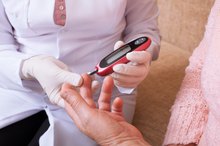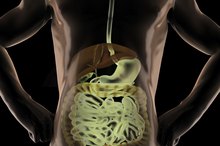Causes of High Insulin Levels
Insulin, a potent hormone released by the pancreas, keeps blood sugar levels in a healthy range. People with type 1 diabetes do not make enough insulin to maintain normal blood sugar levels. In type 2 diabetes, however, insulin levels can actually spike in an effort to overcome the body's resistance to its effects. Other causes of high insulin levels include pregnancy and insulin-secreting tumors.
Insulin Resistance
The development of type 2 diabetes is preceded by a condition known as insulin resistance, or impaired glucose tolerance 1. Risk factors for insulin resistance include being overweight or obese, lack of regular physical activity and older age 1. Insulin resistance occurs when the body's tissues are no longer sensitive to the effects of insulin, causing blood sugar levels to rise above normal 1. As blood sugar levels increase, insulin levels surge as well. In the early stages of type 2 diabetes, insulin levels typically remain higher than normal. With long-standing type 2 diabetes, however, the insulin-producing cells of the pancreas may burn out, causing reduced insulin levels. When this occurs, insulin injections may become necessary to control blood sugar.
- The development of type 2 diabetes is preceded by a condition known as insulin resistance, or impaired glucose tolerance 1.
- In the early stages of type 2 diabetes, insulin levels typically remain higher than normal.
Pregnancy
Complications of Untreated Type 2 Diabetes
Learn More
Over the course of a normal pregnancy, insulin levels rise as the fetus grows larger. By late pregnancy, sensitivity to insulin decreases, causing insulin levels to spike. Although insulin resistance is normal in late-stage pregnancy, some develop a pregnancy-related form of diabetes known as gestational diabetes 1. Women with this condition typically have further increases in their insulin levels. Although estimates vary, the American Diabetes Association reports that as many as 18 percent of pregnancies are complicated by gestational diabetes. Being overweight before pregnancy, a family history of diabetes and a personal history of high blood pressure are risk factors for gestational diabetes.
- Over the course of a normal pregnancy, insulin levels rise as the fetus grows larger.
- Although estimates vary, the American Diabetes Association reports that as many as 18 percent of pregnancies are complicated by gestational diabetes.
Insulin-Secreting Tumors
In rare cases, an insulin-secreting tumor, called an insulinoma, can cause high insulin levels. Insulinomas are typically small tumors that are usually found in the pancreas. Women over the age of 50 are most commonly affected. The majority of insulinomas are not cancerous, report authors of a November 2008 review article in "Cases Journal." Even so, an insulinoma can cause dangerously low blood sugar levels due to surges in insulin produced by the tumor. Symptoms of low blood sugar include tremors, sweating, dizziness and confusion.
- In rare cases, an insulin-secreting tumor, called an insulinoma, can cause high insulin levels.
Evaluation
Can Low Progesterone Keep the HCG Levels From Rising?
Learn More
Depending on the underlying condition, high insulin levels can have different effects. In people with insulin resistance, spikes in insulin can signal the development of type 2 diabetes 1. While insulin levels are generally not measured directly, the American Diabetes Association recommends close monitoring of blood sugar levels in people with insulin resistance to help prevent the development of type 2 diabetes 1. The American College of Obstetricians and Gynecologists recommends that all pregnant women be screened for gestational diabetes during their third trimester. When an insulin-secreting tumor is suspected, a special CT scan, MRI or ultrasound is usually performed to pinpoint the exact location before surgery to remove the tumor.
- Depending on the underlying condition, high insulin levels can have different effects.
- In people with insulin resistance, spikes in insulin can signal the development of type 2 diabetes 1.
Related Articles
References
- Scientifica: Nutritional Modulation of Insulin Resistance
- Cases Journal: Preoperative Detection of Insulinomas -- Two Case Reports
- National Guideline Clearinghouse: Gestational Diabetes Mellitus
- National Institute of Diabetes and Digestive and Kidney Diseases. Insulin resistance and prediabetes. Updated May 2018.
- Meigs, JB. Patient education: The metabolic syndrome (beyond the basics). UptoDate. Updated April 17, 2019.
- National Heart, Lung, and Blood Institute. Metabolic syndrome.
- Deboer MD. Ethnicity, obesity and the metabolic syndrome: implications on assessing risk and targeting intervention. Expert Rev Endocrinol Metab. 2011;6(2):279-289. doi:10.1586%2Feem.11.17
- Vargas E, Podder V, Sepulveda MAC. Physiology, glucose transporter Type 4 (GLUT4). StatPearls Publishing. Updated August 18, 2019.
- Bailey CJ. Insulin resistance: Impact on therapeutic developments in diabetes. Diab Vasc Dis Res. 2019;16(2):128-132. doi:10.1177/1479164119827570.
- American Diabetes Association. 2. Classification and diagnosis of diabetes: Standards of medical care in diabetes-2020. Diabetes Care. 2020 Jan;43(Suppl 1):S14-S31. doi:10.2337/dc20-S002
- National Institute of Diabetes and Digestive and Kidney Diseases. The A1C Test and Diabetes. Updated April 2018.
- Sun J, Wang Y, Zhang X, He H. The effects of metformin on insulin resistance in overweight or obese children and adolescents: A PRISMA-compliant systematic review and meta-analysis of randomized controlled trials. Medicine. 2019;98(4):e14249. doi:10.1097/MD.0000000000014249.
- McCulluch DK. Thiazolidinediones in the treatment of diabetes mellitus. UptoDate.
Writer Bio
Niya Jones is a physician and medical writer. She is board-certified in internal medicine and has a special interest in cardiology, particularly as it relates to health care disparities and women's health. She received her medical degree and Masters of public health from Yale University.








